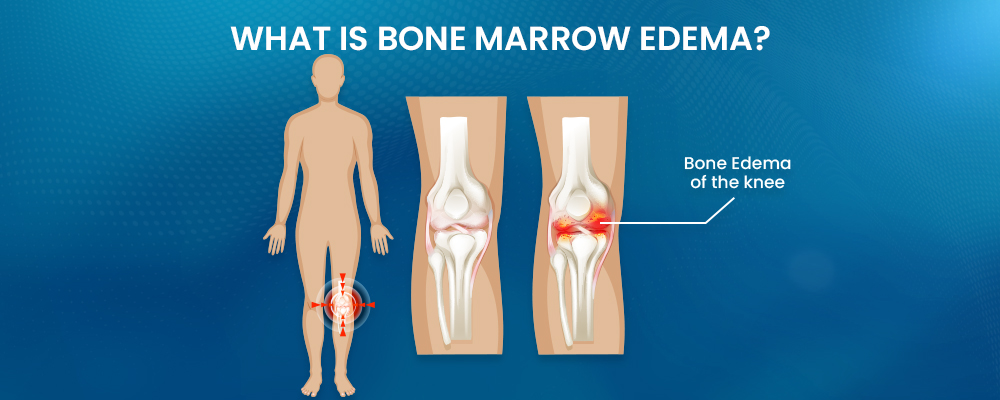
Bone marrow edema (BME) occurs when fluid builds up in the soft, spongy tissue inside your bones, called bone marrow. This tissue contains blood stem cells, which eventually become red blood cells, white blood cells, or platelets. When fluid collects, it causes swelling, also known as edema. Doctors often refer to bone marrow edema as bone marrow lesions.

What Causes Bone Marrow Edema?
Bone marrow edema (BME) happens when fluid builds up in the soft tissues inside your bones. This buildup causes swelling and often leads to pain. There are many possible causes of BME. Below, we’ll break down the most common ones.
Arthritis
Arthritis is a common cause of bone marrow edema. It involves inflammation or degeneration of joints, which puts pressure on the bone marrow. Types of arthritis linked to BME include:
- Osteoarthritis: Wear-and-tear damage to joints.
- Rheumatoid arthritis: An autoimmune disease attacking joints.
- Psoriatic arthritis: A form linked to psoriasis.
- Gout: A painful buildup of uric acid crystals.
- Septic arthritis: Caused by infections in or near a joint.
- Reactive arthritis: Triggered by certain medications or infections.
Osteoporosis
Osteoporosis makes bones weak and brittle. It is more common in older adults, especially postmenopausal women. With osteoporosis, bones are more likely to break, which can cause BME. This condition is often temporary but can flare up over time.
Bone Infections
Bone infections, called osteomyelitis, are another cause of BME. These infections damage blood vessels in the bone, which can lead to tissue death, also known as osteonecrosis. Osteomyelitis is often caused by bacteria like Staphylococcus aureus.
Injury
BME often results from injuries. These can be sudden or from overuse. When an injury happens, inflammation occurs. This swelling helps protect the area but also causes discomfort. Injuries that may lead to BME include:
- Stress fractures.
- Tendinitis.
- Bone bruises.
- ACL tears.
- Dislocated joints.
- Plantar fasciitis.
- Achilles tendon ruptures.
- Complex regional pain syndrome (CRPS).
Bone Tumors
Some bone tumors, even non-cancerous ones, can cause BME. As these tumors grow, they put stress on the bone marrow. Examples of benign bone tumors include:
- Chondroblastomas (often painful).
- Enchondromas (grow inside the bone marrow).
- Giant cell tumors (rare but aggressive).
- Osteochondromas (a type that develops outside the bone).
Cancer
BME can also happen with cancer. It may result from cancers that start in the bone or spread there from other parts of the body. Cancers linked to BME include:
- Osteosarcoma
- Non-Hodgkin lymphoma
- Multiple myeloma
- Leukemia
Additionally, cancers like breast cancer, lung cancer, prostate cancer, kidney cancer, and thyroid cancer are more likely to spread to the bones and cause BME.

Where Does Bone Marrow Edema Happen?
Bone marrow edema can occur in many areas of your body. However, it’s most common in the:
- Hip
- Knee
- Ankle
- Foot
These areas often experience stress or injury, making them more likely to develop BME.
What Are the Symptoms of Bone Marrow Edema?
The main sign of BME is pain in or around the affected bone. Other symptoms can include:
- Swelling in the joints (joint effusion).
- Warmth around the joints.
In some cases, people with bone marrow edema might not feel any symptoms at all.
Can Bone Marrow Edema Be Cancer?
Many people ask, “Can Bone Marrow Edema Be Cancer?” In most cases, bone marrow edema is linked to injury, inflammation, or degenerative changes rather than cancer. However, in rare circumstances, cancers such as bone tumors, metastatic disease, or blood cancers like leukemia and multiple myeloma can present with or resemble bone marrow edema on imaging. This is why persistent symptoms or concerning signs should always be evaluated by a medical professional.
How Do Doctors Diagnose Bone Marrow Edema?
To diagnose BME, your healthcare provider will start by performing a physical examination. They will ask about your symptoms and your medical history. BME is often discovered when a person is already being treated for another related condition.
If your doctor suspects BME, they may recommend several tests to confirm the diagnosis:
Blood Tests
These tests help detect signs of inflammation in your body. Inflammation is a key indicator of many conditions that can cause BME.
Bone Marrow Biopsy
A biopsy involves taking a small sample of your bone marrow for closer examination. This helps doctors understand the extent of the issue.
DEXA Scan
A DEXA (or DXA) scan looks for osteoporosis, a condition that weakens bones and can lead to BME.
MRI
An MRI (Magnetic Resonance Imaging) is one of the most effective ways to detect bone marrow edema. It creates detailed images of your bones and surrounding tissues, helping your doctor see fluid buildup.
Ultrasound
Ultrasound uses sound waves to produce images of your joints and soft tissues, helping to identify any swelling or changes in the bone marrow.
It’s important to note that CT scans and X-rays do not show BME, so they’re not used for diagnosing this condition.
Treatment Options for Bone Marrow Edema
In most cases, BME improves with rest, physical therapy, and pain relief medications like nonsteroidal anti-inflammatory drugs (NSAIDs). Recovery can take several months of rest to feel better.
For more severe cases, your doctor might recommend additional treatments or surgery. One option, called core decompression surgery, involves drilling small holes in the affected bone to relieve pressure and reduce pain. The surgeon may also fill these holes with stem cells or bone graft material to encourage the growth of healthy bone marrow.
Does Bone Marrow Edema Go Away?
In many cases, BME resolves on its own. However, this depends on the underlying cause. If left untreated, the condition may worsen or lead to further complications. Seeking timely medical advice ensures better outcomes.
Is Bone Marrow Edema Serious
In most cases, bone marrow edema is linked to another condition, like cancer, osteomyelitis (bone infection), arthritis, or an injury. If you’re wondering, “Is Bone Marrow Edema Serious?” the most common complication is pain, which can be severe and affect your daily life. While symptoms often improve on their own or with treatment of the underlying cause, the pain can still be challenging to manage in the meantime.
In rare cases, bone marrow edema can occur without any clear cause. This is known as bone marrow edema syndrome (BMES). It is most commonly seen in men or individuals assigned male at birth (AMAB), typically between the ages of 30 and 60. It causes sudden or gradual pain and swelling in the lower parts of the body, mainly the hips, knees, ankles, or feet.
The pain may be noticeable even when you’re resting, but it tends to get worse with movement or at night. It can affect one side of the body (unilateral) or both sides (bilateral).
Doctors diagnose BMES when they see edema on an MRI scan and can’t find any other cause. MRI is the best imaging tool for detecting bone marrow edema because it shows soft tissues more clearly than X-rays or CT scans.
The Impact of Clinical Trials on Cancer Care Progress
Clinical trials for cancer play a significant role in advancing cancer research. They provide scientists and doctors with valuable insights into the effectiveness of new treatments, therapies, and diagnostic methods. Through rigorous testing and observation, these trials help identify better ways to manage and potentially cure various types of cancer, improving survival rates and quality of life for patients worldwide.
For example, ongoing multiple myeloma clinical trials are testing new treatments. By enrolling, patients can access innovative therapies that may not be available through standard care, while also helping advance treatment options for future patients.
Also Read: Understanding Smoldering Multiple Myeloma
Conclusion:
Bone marrow edema (BME) is a condition that can result from various causes, including arthritis, injuries, osteoporosis, infections, or cancer. Though often painful, it is treatable with rest, therapy, medications, and, in severe cases, surgical intervention. Early diagnosis through tools like MRI and timely medical care are crucial for managing symptoms and preventing complications.







